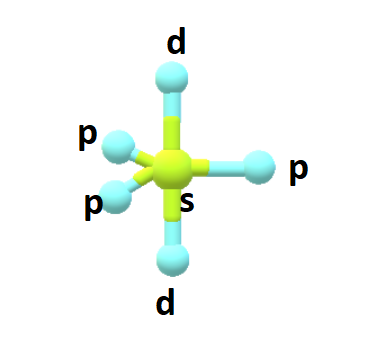
Explain \[s{p^3}d\] hybridization by taking a suitable example.
Answer
424.9k+ views
Hint: to explain hybridization one should know the concepts of steric number and the details of that molecule such as the lone pair and the number and types of bonds present in the molecule.
Complete step by step solution:
\[s{p^3}d\] hybridization consists of one ‘s’, three ‘p’ and one ‘d’ orbitals. They are almost of the same energy which are intermixed to give 5 identical and degenerate hybrid orbitals. They are arranged in trigonal bipyramidal symmetry.
To explain their symmetry-

Amongst the five degenerate hybrid orbitals ,three of them are arranged in a trigonal plane and the remaining two orbitals are present above and below the trigonal plane at right angles.
Percentage (%) of s , p , d characters in the molecule-
The \[s{p^3}d\] hybrid orbitals consist of 20% ‘s’,60% ‘p’ and 20% ‘d’ characters.
For example-
The \[PC{l_5}\]molecule has five orbitals i.e. 1s,3p and 1d are intermixed to get 5 degenerate hybrid orbitals \[s{p^3}d\] of the same energy. They are directed to the 5 corners of the trigonal bipyramidal. All the bond angles in trigonal bipyramidal are not identical.
In \[PC{l_5}\] molecules the five hybrid orbitals of phosphorus overlap with p orbitals of chlorine atoms. The p orbitals of the molecule are singly occupied. Together they form 5 \[P - Cl\] sigma bonds.
The Equatorial bonds-
The 3 \[P - Cl\] bonds which lie in the trigonal plane make an angle with one another. The angle between them is \[{120^ \circ }\].
Axial bonds-
The 2 \[P - Cl\] bonds where one lies above the equatorial plane and the other below make an angle of \[{90^ \circ }\] with the plane.
Note: Students often consider the pie bonds during the calculation of hybridization. But it is only the sigma bonds which participate. One should keep in mind that different hybridisation provides the different way of arrangement in the space.
Complete step by step solution:
\[s{p^3}d\] hybridization consists of one ‘s’, three ‘p’ and one ‘d’ orbitals. They are almost of the same energy which are intermixed to give 5 identical and degenerate hybrid orbitals. They are arranged in trigonal bipyramidal symmetry.
To explain their symmetry-

Amongst the five degenerate hybrid orbitals ,three of them are arranged in a trigonal plane and the remaining two orbitals are present above and below the trigonal plane at right angles.
Percentage (%) of s , p , d characters in the molecule-
The \[s{p^3}d\] hybrid orbitals consist of 20% ‘s’,60% ‘p’ and 20% ‘d’ characters.
For example-
The \[PC{l_5}\]molecule has five orbitals i.e. 1s,3p and 1d are intermixed to get 5 degenerate hybrid orbitals \[s{p^3}d\] of the same energy. They are directed to the 5 corners of the trigonal bipyramidal. All the bond angles in trigonal bipyramidal are not identical.
In \[PC{l_5}\] molecules the five hybrid orbitals of phosphorus overlap with p orbitals of chlorine atoms. The p orbitals of the molecule are singly occupied. Together they form 5 \[P - Cl\] sigma bonds.
The Equatorial bonds-
The 3 \[P - Cl\] bonds which lie in the trigonal plane make an angle with one another. The angle between them is \[{120^ \circ }\].
Axial bonds-
The 2 \[P - Cl\] bonds where one lies above the equatorial plane and the other below make an angle of \[{90^ \circ }\] with the plane.
Note: Students often consider the pie bonds during the calculation of hybridization. But it is only the sigma bonds which participate. One should keep in mind that different hybridisation provides the different way of arrangement in the space.
Recently Updated Pages
The correct geometry and hybridization for XeF4 are class 11 chemistry CBSE

Water softening by Clarks process uses ACalcium bicarbonate class 11 chemistry CBSE

With reference to graphite and diamond which of the class 11 chemistry CBSE

A certain household has consumed 250 units of energy class 11 physics CBSE

The lightest metal known is A beryllium B lithium C class 11 chemistry CBSE

What is the formula mass of the iodine molecule class 11 chemistry CBSE

Trending doubts
State the laws of reflection of light

Arrange Water ethanol and phenol in increasing order class 11 chemistry CBSE

One Metric ton is equal to kg A 10000 B 1000 C 100 class 11 physics CBSE

Difference Between Prokaryotic Cells and Eukaryotic Cells

A mixture of o nitrophenol and p nitrophenol can be class 11 chemistry CBSE

How do I convert ms to kmh Give an example class 11 physics CBSE




